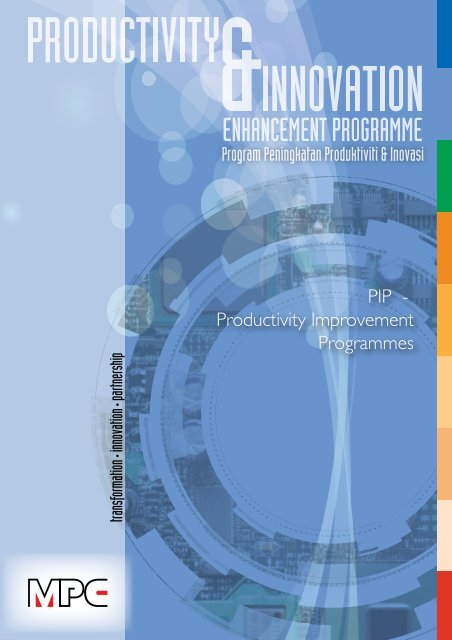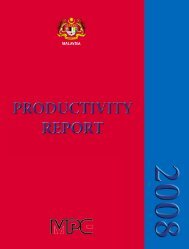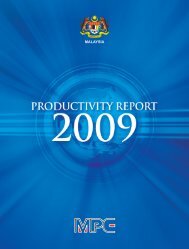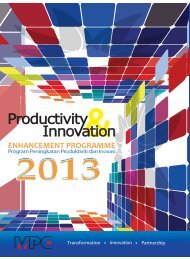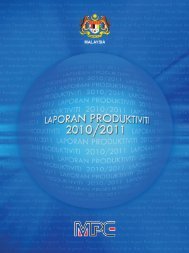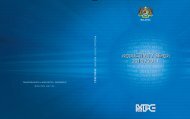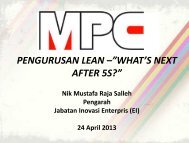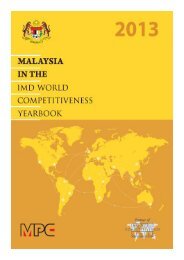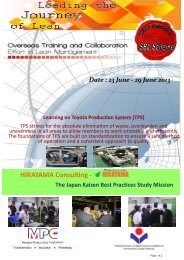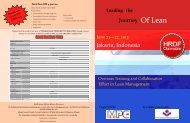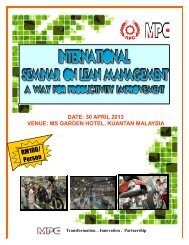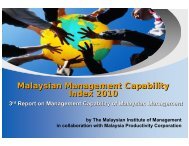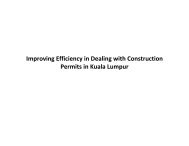PIP - Productivity Improvement Programmes Program ... - MPC
PIP - Productivity Improvement Programmes Program ... - MPC
PIP - Productivity Improvement Programmes Program ... - MPC
You also want an ePaper? Increase the reach of your titles
YUMPU automatically turns print PDFs into web optimized ePapers that Google loves.
<strong>Program</strong> Peningkatan Produktiviti & Inovasi<br />
transformation ∙ innovation ∙ partnership<br />
<strong>PIP</strong> -<br />
<strong>Productivity</strong> <strong>Improvement</strong><br />
<strong><strong>Program</strong>mes</strong>
8<br />
PRODUCTIVITY & INNOVATION ENHANCEMENT PROGRAMMES 2012<br />
<strong>PIP</strong> List of <strong><strong>Program</strong>mes</strong> Page<br />
101 7 New QC Tools for Quality Practitioners 10<br />
102 Audit Dalaman Amalan Persekitaran Berkualiti 12<br />
103<br />
Balanced Scorecard-A Linkage to Business<br />
Performance<br />
14<br />
104 Best Practices in Customer Relationship Management 16<br />
105 Creating Value Through <strong>Productivity</strong> Measurement 18<br />
106 Enhancing Enterprise Capability Through e-Biz 20<br />
107 Failure Mode And Effect Analysis (FMEA) 22<br />
108 Gemba Best Practices For Operational Excellence 24<br />
109 ICC For Facilitators 26<br />
110 ICC Untuk Ahli Kumpulan 28<br />
111 ICC Untuk Ketua Kumpulan 30<br />
112 Innovation Tools for Service Sector 32<br />
113<br />
Interactive <strong>Productivity</strong>-Linked Waged System<br />
(I - PLWS)<br />
34<br />
114 Judging ICC Presentation Effectively 36<br />
115 Lean Production System : The Toyota Way 38<br />
116<br />
Lean Supply Chain Management For Managers<br />
(Lean SCM)<br />
40
PROGRAM PENINGKATAN PRODUKTIVITI & INOVASI 2012 9<br />
<strong>PIP</strong> List of <strong><strong>Program</strong>mes</strong> Page<br />
117<br />
Managing for Result: Using KPI to Achieve<br />
Breakthrough Performance<br />
42<br />
118 Pengukuran Produktiviti Syarikat dengan COMPASS 44<br />
119<br />
Peningkatan Daya Saing Melalui Pembangunan<br />
Laman Web<br />
46<br />
120 Practical Lean Management 48<br />
121 Project Management 50<br />
122<br />
Quality Environment Management System -<br />
5S Practices<br />
52<br />
123 Quality Environment Internal Audit 54<br />
124 Risk Management 56<br />
125 Sistem Pengurusan Persekitaran Berkualiti - Amalan 5S 58<br />
126 Six Sigma <strong>Improvement</strong> Methodology and Tools 60<br />
127 Statistical Process Control 62<br />
128 Strategi Pemasaran 64<br />
129<br />
Strengthening Lean Manufacturing Through Kaizen<br />
Practices<br />
66<br />
130 TQM for Organisational Excellence 68<br />
131 Visual Control Management 70
10<br />
PRODUCTIVITY & INNOVATION ENHANCEMENT PROGRAMMES 2012<br />
<strong>PIP</strong> 101:<br />
7 NEW QC TOOLS FOR QUALITY<br />
PRACTITIONERS<br />
RATIONALE<br />
The traditional 7 QC tools are used in ICC activities to uncover the<br />
problem, arrange the data, analyse the causes, undertake counter<br />
measures for improvement, and to ensure continuous improvement.<br />
Most of them will involve numerical data in their applications. The 7<br />
new QC tools are techniques for managers and their staff to use at the<br />
planning stage to set out the important direction towards organisation’s<br />
improvement.<br />
OBJECTIVES<br />
At the end of the programme, participants should be able to:<br />
• Understand the 7 new QC tools<br />
• Apply the new QC tools
PROGRAM PENINGKATAN PRODUKTIVITI & INOVASI 2012 11<br />
CONTENTS<br />
DAY 1<br />
• Introduction to quality and quality<br />
improvement<br />
• Problem solving methodology<br />
• Recapitulation of the 7 QC tools<br />
• Introduction to 7 new QC tools<br />
- Affinity Diagram<br />
- Relationship Diagram<br />
DAY 2<br />
• Continue<br />
- Tree Diagram<br />
- Prioritisation Matrix<br />
- Matrix Diagram<br />
- Process Decision <strong>Program</strong>me<br />
Chart (PDPC)<br />
- Arrow Diagram<br />
• Implementation of the 7 New QC<br />
Tools<br />
METHODOLOGY<br />
DURATION<br />
2 days<br />
• Lecture<br />
• Group Work<br />
• Exercise<br />
WHO SHOULD<br />
ATTEND<br />
• Top management<br />
• Executive<br />
• Supervisor
12<br />
PRODUCTIVITY & INNOVATION ENHANCEMENT PROGRAMMES 2012<br />
<strong>PIP</strong> 102:<br />
AUDIT DALAMAN AMALAN PERSEKITARAN<br />
BERKUALITI<br />
RASIONAL<br />
Aktiviti Amalan Persekitaran Berkualiti memerlukan beberapa langkah<br />
praktikal untuk memastikan amalannya menjadi budaya kerja. Di<br />
samping aktiviti promosi dan latihan aktiviti audit dalaman adalah<br />
penting untuk mengukur tahap pencapaian amalan ini sepanjang masa.<br />
Tindakan pembetulan atau penambahbaikan boleh diambil selepas<br />
audit dalaman ini dijalankan. Kaedah ini merupakan satu proses agar<br />
sistem ini menjadi amalan berterusan di kalangan pekerja-pekerja<br />
sesebuah syarikat.<br />
OBJEKTIF<br />
Di akhir program ini, peserta akan dapat:<br />
• Memahami kepentingan audit dalaman Sistem Amalan Persekitaran<br />
Berkualiti<br />
• Memperolehi pendedahan yang tepat tentang kaedah menjalankan<br />
aktiviti audit dalaman<br />
• Mengetahui aspek audit seperti dokumentasi dan praktikal Amalan<br />
Persekitaran Berkualiti<br />
• Mempunyai keyakinan menjadi juruaudit dalaman
PROGRAM PENINGKATAN PRODUKTIVITI & INOVASI 2012 13<br />
KANDUNGAN<br />
HARI 1<br />
• Asas audit Amalan Persekitaran<br />
Berkualiti<br />
• Kriteria untuk pemarkahan audit<br />
• Aspek penilaian, kriteria penilaian<br />
• Pengukuran KPI dalam Amalan<br />
Persekitaran Berkualiti<br />
• Pelan aktiviti audit Amalan<br />
Persekitaran Berkualiti dan kaedah<br />
penilaian<br />
• Latihan audit dalaman<br />
(perkongsian pengalaman dengan<br />
organisasi contoh)<br />
HARI 2<br />
• Pembentangan kumpulan dan mengurus keputusan audit<br />
• Skim insentif, merekod aktiviti penambahbaikan<br />
METODOLOGI<br />
JANGKAMASA<br />
2 hari<br />
• Syarahan<br />
• Kerja berkumpulan<br />
• Latihan<br />
SIAPA YANG<br />
PATUT HADIR<br />
• Pengurusan atasan<br />
• Pengurus / Eksekutif<br />
• Penyelia
14<br />
PRODUCTIVITY & INNOVATION ENHANCEMENT PROGRAMMES 2012<br />
<strong>PIP</strong> 103:<br />
BALANCED SCORECARD-A LINKAGE TO<br />
BUSINESS PERFORMANCE<br />
RATIONALE<br />
Global competition is forcing companies worldwide to review ways<br />
of becoming more effective, efficient and productive. Balanced<br />
Scorecard (BSC) provides managers with the instrument to navigate<br />
future competitive success. It enables management to translate<br />
an organisation’s mission and strategy into a comprehensive set of<br />
performance measures that provide the framework for a strategic<br />
measurement and management system.<br />
OBJECTIVES<br />
At the end of the programme, participants should be able to:<br />
• Understand the fundamentals of the BSC<br />
• Enhance their knowledge in developing a BSC as strategic business<br />
tool<br />
• Gain hands-on experience and initiate their own BSC
PROGRAM PENINGKATAN PRODUKTIVITI & INOVASI 2012 15<br />
CONTENTS<br />
DAY 1<br />
• Introduction to BSC<br />
- Concept and philosophy<br />
• BSC framework<br />
• BSC perspectives:<br />
- Financial perspective<br />
- Customers perspective<br />
- Learning and growth<br />
perspective<br />
- Internal business process<br />
perspective<br />
• Linking BSC to Integrated<br />
Strategic Objectives<br />
DAY 2<br />
• Developing Key Performance<br />
Indicators (KPIs)<br />
• Steps in building BSC<br />
• Measuring BSC Performance<br />
• Utilising and maintaining BSC for<br />
company’s advantage<br />
METHODOLOGY<br />
DURATION<br />
2 days<br />
• Lecture<br />
• Group Work<br />
• Exercise<br />
WHO SHOULD<br />
ATTEND<br />
• Top management<br />
• Executive<br />
• Supervisor
16<br />
PRODUCTIVITY & INNOVATION ENHANCEMENT PROGRAMMES 2012<br />
<strong>PIP</strong> 104:<br />
BEST PRACTICES IN CUSTOMER<br />
RELATIONSHIP MANAGEMENT<br />
RATIONALE<br />
The success of a business depends in its customers. Fulfilling customer<br />
needs and delighting customers are essential ingredients for acquiring<br />
and maintaining customers’ loyalty to a business. In today’s environment,<br />
companies not only need to acquire new customers but they also need<br />
to retain and create customer following and customer loyalty in the<br />
market place. Every company or organisation will always be involved<br />
in Customer Relationship Management (CRM) even if only in an ad hoc<br />
manner. CEOs, Top Management and Managers of companies should<br />
be familiar with the techniques and technologies of CRM at his or her<br />
disposal. This course provides participants with exposures to those<br />
best practices techniques and technologies of CRM, specifically the<br />
essential elements of CRM best practices that have proven to work and<br />
those practices that are not working to ease participants to understand<br />
the actual CRM best practices base on actual case experiences. The<br />
course will guide you to achieve greater CRM effectiveness by helping<br />
you to learn, appreciate, internalise and recognise what constitute a<br />
superior CRM formula.<br />
OBJECTIVES<br />
At the end of the programme, the participants should be able to:<br />
• Understand the role of CRM as a tool towards being customer driven<br />
organisation<br />
• Understand the significance of CRM on the company’s bottom line<br />
• Acquire CRM best practices techniques and methodologies as a<br />
guide for implementation<br />
• Examine organisations readiness and capability to implement CRM<br />
• Identify relevant CRM technology that suits organisational<br />
requirements<br />
• Evaluate a successful CRM efforts
PROGRAM PENINGKATAN PRODUKTIVITI & INOVASI 2012 17<br />
CONTENTS<br />
DAY 1<br />
• Introduction to CRM<br />
• Why is CRM important to<br />
organisations<br />
• Customer Driven Enterprise and<br />
barriers to being customer driven<br />
DAY 2<br />
• Enabling CRM<br />
• Evaluating CRM Solutions<br />
• Economies and strategies of CRM<br />
• Application of CRM: Case<br />
Experience<br />
METHODOLOGY<br />
DURATION<br />
2 days<br />
• Lecture<br />
• Group Work<br />
WHO SHOULD<br />
ATTEND<br />
• Manager<br />
• Executive<br />
• Quality Practitioner<br />
• Supervisor
18<br />
PRODUCTIVITY & INNOVATION ENHANCEMENT PROGRAMMES 2012<br />
<strong>PIP</strong> 105:<br />
CREATING VALUE THROUGH<br />
PRODUCTIVITY MEASUREMENT<br />
RATIONALE<br />
“What gets measured, gets managed”. This quote relates to the<br />
importance of productivity measurement in the business scenario.<br />
“In view of global challenges and financial crisis, Malaysian industries<br />
should measure productivity and implement productivity initiatives in<br />
order to improve their performance and competitiveness. It is essential<br />
for companies to measure productivity and implement productivity<br />
improvement programmes to increase their performance and enhance<br />
competitiveness. Inappropriate measurements may lead to poor<br />
interpretation of the company’s performance and affect its planning.<br />
OBJECTIVES<br />
At the end of this course, participants should be able to:<br />
• Understand the value creation concept and productivity analysis<br />
• Analyse and interpret productivity through company financial<br />
statement
PROGRAM PENINGKATAN PRODUKTIVITI & INOVASI 2012 19<br />
CONTENTS<br />
DAY 1<br />
• Introduction to productivity<br />
• <strong>Productivity</strong> concept<br />
• <strong>Productivity</strong> measurement through<br />
added value<br />
• Understanding AV, BIMS, NOE,<br />
NOI<br />
• <strong>Productivity</strong> analysis<br />
- <strong>Productivity</strong> ratio<br />
- <strong>Productivity</strong> relationship<br />
DAY 2<br />
• <strong>Productivity</strong> measurement using COMPASS software<br />
• Case study analysis<br />
• Demonstration of COMPASS software<br />
METHODOLOGY<br />
DURATION<br />
2 days<br />
• Lecture<br />
• Group Work<br />
• Exercise<br />
WHO SHOULD<br />
ATTEND<br />
• Top Management<br />
• Executive<br />
• Supervisor
20<br />
PRODUCTIVITY & INNOVATION ENHANCEMENT PROGRAMMES 2012<br />
<strong>PIP</strong> 106:<br />
ENHANCING ENTERPRISE CAPABILITY<br />
THROUGH E-BIZ<br />
RATIONALE<br />
E-Business refers to more strategic focus with an emphasis on the<br />
functions that occur using electronic capabilities, e-Commerce is a<br />
subset of an overall e-Business strategy involving the application of<br />
knowledge management systems. E-Commerce seeks to add revenue<br />
streams using the Internet to build and enhance relationships with<br />
clients and partners and to improve efficiency using the Empty Vessel<br />
strategy.<br />
E-Business involves electronic purchasing and supply chain<br />
management, processing orders electronically, handling customer<br />
service, and cooperating with business partners. Special technical<br />
standards for e-Business facilitate the exchange of data between<br />
companies. E-Business software solutions allow the integration of<br />
intra and inter firm business processes using the Web, the Internet,<br />
intranets, extranets, or some combination of these.<br />
OBJECTIVES<br />
Upon completion, participants will:<br />
• Have an appreciation on the impact of e-Commerce in their day-today<br />
business activities<br />
• Have an understanding on the building blocks of e-Commerce -<br />
product catalogue, payment gateway, merchant account, order<br />
fulfillment and security<br />
• Have project specifications and an e-Commerce implementation<br />
timeline
PROGRAM PENINGKATAN PRODUKTIVITI & INOVASI 2012 21<br />
CONTENTS<br />
Part 1<br />
• Introduction to e-Commerce<br />
• Introduction to How e-Commerce<br />
Works<br />
• The e-Commerce Phenomenon<br />
• Commerce<br />
• The Elements of Commerce<br />
• Why the Hype?<br />
• E-Commerce Website Models<br />
DAY 1<br />
DAY 2<br />
• The Lure of e-Commerce<br />
• Easy and Hard Aspects of<br />
e-Commerce<br />
Part 2<br />
• Discovering Your Purpose<br />
• Finding your Niche<br />
• Targeting your Customers<br />
• Your Website’s Blue Print<br />
Part 3<br />
• Domain Name<br />
• E-mail Account Creation &<br />
management<br />
• Web Store Preparation :-<br />
- Catalog Online<br />
- Shopping Cart<br />
- Receive Payment<br />
• Creating & Launching Your Website<br />
For Your Customers To Access Your<br />
Products & Services 24/7<br />
- Website<br />
- Web Blog<br />
• Creating & Launching Your Web<br />
Store For Your Customers To Access<br />
Your Products & Services 24/7<br />
- StoreFront<br />
- eBay<br />
- iBeli<br />
Part 4<br />
• Marketing Plan<br />
• Search Engine Optimization<br />
• Internet Marketing<br />
• On-site Marketing Techniques<br />
• Online Advertising<br />
• Affiliate <strong>Program</strong>s<br />
METHODOLOGY<br />
• Hands-On Practical<br />
Workshop<br />
WHO SHOULD<br />
ATTEND<br />
• Entrepreneur<br />
• Manager of Multimedia & IT<br />
• Webmaster<br />
• Business Executive<br />
DURATION<br />
2 days
22<br />
PRODUCTIVITY & INNOVATION ENHANCEMENT PROGRAMMES 2012<br />
<strong>PIP</strong> 107:<br />
FAILURE MODE AND EFFECT ANALYSIS<br />
(FMEA)<br />
RATIONALE<br />
Globalisation, intense competition and rapid technology advancement<br />
contribute to the increased in customer demand to produce better<br />
quality products and services. Therefore, Failure Mode and Effect<br />
Analysis (FMEA) is developed to help organisation to analyse potential<br />
reliability problem, identify and counter weak points in the early<br />
conception phase of product and process design.<br />
FMEA is a systematic approach that identifies potential failure modes in<br />
a system, product or manufacturing/assembly operation caused either<br />
by design failure or manufacturing /assembly process deficiencies.<br />
FMEA helps to identify critical or significant design or process<br />
characteristics that require special controls to prevent or detect failure<br />
modes. Since reliability, consistency and predictability play a major<br />
role in the world of quality, eliminating failure modes will ensure and<br />
improve the reliability of the products.<br />
OBJECTIVES<br />
At the end of the programme, the participants should be able to:<br />
• Understand the concept, philosophy, objectives and benefits of<br />
using FMEA<br />
• Understand the methodology to develop, design and prepare<br />
FMEA<br />
• Identify the steps taken in developing and implementing FMEA
PROGRAM PENINGKATAN PRODUKTIVITI & INOVASI 2012 23<br />
CONTENTS<br />
DAY 1<br />
• Introduction and foundation of<br />
FMEA<br />
• Reliability and failure mode<br />
analysis<br />
• FMEA mapping methodology<br />
DAY 2<br />
• FMEA application program<br />
- Design FMEA<br />
- Process FMEA<br />
• FMEA risk assessment<br />
methodology<br />
• FMEA control plan development<br />
METHODOLOGY<br />
DURATION<br />
2 days<br />
• Lecture<br />
• Group Work<br />
• Exercise<br />
WHO SHOULD<br />
ATTEND<br />
• Top management<br />
• Executive<br />
• Supervisor
24<br />
PRODUCTIVITY & INNOVATION ENHANCEMENT PROGRAMMES 2012<br />
<strong>PIP</strong> 108:<br />
GEMBA BEST PRACTICES FOR<br />
OPERATIONAL EXCELLENCE<br />
RATIONALE<br />
In business, Gemba refers to the place where value is created and<br />
the general notion is that the best creative improvement ideas will<br />
come simply from going to the Gemba. The ‘Gemba Kaizen’ is an<br />
activity that takes management to the front lines to look for waste and<br />
opportunities to practice which is similar to the “western” concept<br />
of MBWA (Management by Walking Around) The result: greater<br />
productivity, quality, and profits achieved with minimal cost, time, and<br />
effort invested. These indicators represent the transformation towards<br />
sustaining Operational Excellence for market competitiveness. Masaaki<br />
Imai in his famous book “Gemba Kaizen” defines “ Gemba means “the<br />
actual place” and Kaizen means “Continuous improvement activities”<br />
and to remain competitive, organisations have to continuously improve<br />
their Operational Excellence.<br />
OBJECTIVES<br />
At the end of the program, participants should able to:<br />
• Contextualise the Gemba Kaizen concepts of quality, process and<br />
quality improvement strategies, methodologies and basic tools<br />
• Understand Gemba Kaizen quality improvement process to reduce<br />
cost, time and improve product quality, service and delivery<br />
• Develop action plan for continuous performance improvement in<br />
organisations
PROGRAM PENINGKATAN PRODUKTIVITI & INOVASI 2012 25<br />
CONTENTS<br />
DAY 1<br />
• The Necessity and Importance of<br />
Gemba Kaizen Activities<br />
• Basic Approaches to Gemba<br />
Kaizen Activities<br />
• Case Study of Gemba Kaizen<br />
Activities<br />
• Gemba Kaizen Benchmarked<br />
practice<br />
• Individual and Group oriented<br />
Gemba Kaizen<br />
DAY 2<br />
• Process of Gemba Kaizen<br />
• Gemba Kaizen tools (Checklist,<br />
Standard Operating Procedure,<br />
ICC/QC Story, Kanban)<br />
• CASE STUDY: Quality<br />
improvement strategies and<br />
methodologies to improve<br />
business performance - reducing<br />
cost, cycle time, errors and<br />
improving internal and external<br />
customer satisfaction<br />
• Establishing Gemba Kaizen critical<br />
measures of process efficiency<br />
and effectiveness<br />
• Key challenges and lessons learnt<br />
in successfully implementing<br />
Gemba Kaizen quality<br />
improvement programme.<br />
• Action planning for continuous<br />
improvement<br />
METHODOLOGY<br />
DURATION<br />
2 days<br />
• Lecture<br />
• Group Work<br />
• Exercise<br />
WHO SHOULD<br />
ATTEND<br />
• Human Resource Personnel<br />
• Executive<br />
• Supervisor
26<br />
PRODUCTIVITY & INNOVATION ENHANCEMENT PROGRAMMES 2012<br />
<strong>PIP</strong> 109:<br />
ICC FOR FACILITATORS<br />
RATIONALE<br />
The roles of ICC facilitator is to facilitate, motivate and provide group<br />
members with the concepts and implementation of ICC project. The<br />
facilitator also act as a mediator between management and the group<br />
to solve any problems pertaining to ICC. This programme highlights<br />
the importance of roles, knowledge and exposure that a facilitator<br />
should acquire to execute the activities.<br />
OBJECTIVES<br />
At the end of the programme, participants should be able to:<br />
• Understand the basic concept, operation and philosophy of ICC<br />
• Train, facilitate and guide ICC members in carrying out their projects<br />
• Determine the feasibility of ICC activities in their own organisation
PROGRAM PENINGKATAN PRODUKTIVITI & INOVASI 2012 27<br />
CONTENTS<br />
DAY 1<br />
• ICC: Concept and philosophy<br />
- Structure and operation of<br />
ICC<br />
- Facilitators : Roles and<br />
responsibilities<br />
- Group Leader : Roles and<br />
responsibilities<br />
- Circle Member : Roles and<br />
responsibilities<br />
• Concept of problem solving<br />
- PDCA Cycle<br />
DAY 2<br />
• Introduction to 7 QC tools:<br />
- Check Sheet<br />
- Cause and Effect Diagram<br />
- Pareto Diagram<br />
- Graphs and Charts<br />
- Scatter Diagram<br />
- Histogram<br />
- Control Chart<br />
• ICC Project : Format and<br />
Guidelines<br />
• ICC Project : Preparation<br />
• Presentation of ICC Project<br />
METHODOLOGY<br />
DURATION<br />
2 days<br />
• Lecture<br />
• Group Work<br />
• Exercise<br />
WHO SHOULD<br />
ATTEND<br />
• Top management<br />
• Executive<br />
• Supervisor
28<br />
PRODUCTIVITY & INNOVATION ENHANCEMENT PROGRAMMES 2012<br />
<strong>PIP</strong> 110:<br />
ICC UNTUK AHLI KUMPULAN<br />
RASIONAL<br />
Dalam pasaran yang kompetitif masa kini, setiap pekerja perlu<br />
menghasilkan barangan dan perkhidmatan dengan lebih berkualiti.<br />
Salah satu kaedah yang efektif adalah melalui penglibatan di dalam<br />
aktiviti kumpulan ‘Innovative and Creative Circle’ (ICC). Aktiviti ini<br />
menyumbang ke arah usaha penambahbaikan berterusan.<br />
OBJEKTIF<br />
Di akhir program ini, para peserta akan dapat:<br />
• Memahami konsep dan falsafah ICC<br />
• Memahami teknik penyelesaian masalah<br />
• Mengaplikasikan teknik dan alat-alat ICC
PROGRAM PENINGKATAN PRODUKTIVITI & INOVASI 2012 29<br />
KANDUNGAN<br />
HARI 1<br />
• Pengenalan konsep dan falsafah<br />
ICC<br />
• Struktur organisasi ICC<br />
- Peranan dan tanggungjawab<br />
ahli kumpulan<br />
• Proses Penyelesaian Masalah<br />
- Kitaran PDCA<br />
• Pengenalan Alat-Alat ICC<br />
- Senarai Semak<br />
- Gambarajah Sebab dan<br />
Akibat<br />
HARI 2<br />
• Sambungan alat-alat ICC<br />
- Gambarajah Pareto<br />
- Carta<br />
• Perbincangan kumpulan dan<br />
latihan<br />
• Persembahan kumpulan<br />
METODOLOGI<br />
JANGKAMASA<br />
2 hari<br />
• Syarahan<br />
• Kerja berkumpulan<br />
• Latihan<br />
SIAPA YANG<br />
PATUT HADIR<br />
• Pengurus / Eksekutif<br />
• Penyelia<br />
• Operator
30<br />
PRODUCTIVITY & INNOVATION ENHANCEMENT PROGRAMMES 2012<br />
<strong>PIP</strong> 111:<br />
ICC UNTUK KETUA KUMPULAN<br />
RASIONAL<br />
Memahami konsep, teknik-teknik penyelesaian masalah dan kemahiran<br />
membuat persembahan adalah penting bagi setiap kumpulan dalam<br />
melaksanakan projek ICC. Pengetahuan ini harus dimiliki oleh setiap<br />
Ketua Kumpulan untuk memimpin kumpulannya dan memberi tunjuk<br />
ajar serta nasihat kepada ahli-ahlinya.<br />
OBJEKTIF<br />
Di akhir kursus, para peserta akan dapat:<br />
• Memperolehi kemahiran untuk mengetuai kumpulan-kumpulan<br />
dalam menjalankan aktiviti ICC<br />
• Pendedahan mengenai teknik dan alat-alat ICC untuk penyelesaian<br />
masalah
PROGRAM PENINGKATAN PRODUKTIVITI & INOVASI 2012 31<br />
KANDUNGAN<br />
HARI 1<br />
• Pengenalan konsep dan falsafah<br />
ICC<br />
• Struktur organisasi ICC<br />
- Peranan dan tanggungjawab<br />
ketua kumpulan<br />
• Proses Penyelesaian Masalah<br />
- Kitaran PDCA<br />
• Pengenalan alat-alat ICC<br />
- Senarai Semak<br />
- Gambarajah Sebab dan<br />
Akibat<br />
HARI 2<br />
• Sambungan alat-alat ICC<br />
- Gambarajah Pareto<br />
- Carta<br />
• Perbincangan kumpulan dan<br />
latihan<br />
• Persembahan kumpulan<br />
METODOLOGI<br />
JANGKAMASA<br />
2 hari<br />
• Syarahan<br />
• Kerja berkumpulan<br />
• Latihan<br />
SIAPA YANG<br />
PATUT HADIR<br />
• Pengurus / Eksekutif<br />
• Penyelia
32<br />
PRODUCTIVITY & INNOVATION ENHANCEMENT PROGRAMMES 2012<br />
<strong>PIP</strong> 112:<br />
INNOVATION TOOLS FOR<br />
SERVICE SECTOR<br />
RATIONALE<br />
Understanding service innovation tools and techniques are vital<br />
to develop effective innovation activities. This will help to solve<br />
the problems and improve the systems to achieve organisation’s<br />
objectives. This course will point out the methods and tools that can<br />
be used to identify and solve problems and eventually to move ahead<br />
with innovation activities for the organisation.<br />
OBJECTIVES<br />
At the end of the programme, the participants should be able to:<br />
• Understand the service innovation tools<br />
• Understand the PDCA concept and applying it to various innovation<br />
techniques<br />
• Gain the expertise in applying service innovation tools in developing<br />
solutions and innovations
PROGRAM PENINGKATAN PRODUKTIVITI & INOVASI 2012 33<br />
CONTENTS<br />
DAY 1<br />
• Concept and definition of service<br />
Innovation<br />
• Approaches to Business<br />
Enhancement<br />
• PDCA cycle, Six Sigma, Innovation<br />
flowcharts<br />
• Introduction to Inno-Tools<br />
• Affinity diagram<br />
• Tree diagram<br />
DAY 2<br />
• The Interrelationship Diagram<br />
• Matrix Diagram<br />
• Activity Network Diagram<br />
• Process Decision <strong>Program</strong> Chart<br />
• Quality Function Deployment<br />
• Failure Mode and Effect Analysis<br />
• Case Study: The Application of<br />
Service Innovation<br />
METHODOLOGY<br />
DURATION<br />
2 days<br />
• Lecture<br />
• Group Work<br />
• Exercise<br />
WHO SHOULD<br />
ATTEND<br />
• Top management<br />
• Executive<br />
• Supervisor
34<br />
PRODUCTIVITY & INNOVATION ENHANCEMENT PROGRAMMES 2012<br />
<strong>PIP</strong> 113:<br />
INTERACTIVE PRODUCTIVITY-LINKED<br />
WAGED SYSTEM (I - PLWS)<br />
RATIONALE<br />
Firms need to ensure that they continuously improve productivity to<br />
enhance their competitive edge. The gains from higher productivity will<br />
enable firms to rationalise cost and sustain labour cost competitiveness<br />
which is crucial in an ever changing economic environment. To ensure<br />
that firms remain cost competitive, the issue of linking wages to<br />
productivity should be given emphasis. Any increase in wages should<br />
be supported by growth in productivity to avoid high cost of production<br />
or service provided. <strong>MPC</strong> has developed an interactive approach<br />
to PLWS through the i-PLWS programme. This hands-on system will<br />
enable firms to simulate their own PLWS Models for implementation at<br />
all levels of the firm.<br />
OBJECTIVES<br />
At the end of the programme, participants should be able to:<br />
• Assist firms in the implementation process of PLWS<br />
• Analyse case examples which can be adapted and adopted at the<br />
firm level<br />
• Enable companies simulate their own PLWS models through the<br />
i-PLWS programme
PROGRAM PENINGKATAN PRODUKTIVITI & INOVASI 2012 35<br />
CONTENTS<br />
DAY 1<br />
• Enhancing productivity and<br />
competitiveness of the firm level<br />
• Policy issues relating to PLWS<br />
• Development of PLWS models<br />
• Case examples and experiences<br />
• S.M.A.R.T principle<br />
• Implementation process<br />
• Benefits of PLWS<br />
• Discussion session<br />
DAY 2<br />
• Overview of the i-PLWS process<br />
• The interactive steps of PLWS<br />
• Simulation of the models and examples<br />
• Practical exercise on the i-PLWS<br />
• Discussion session<br />
METHODOLOGY<br />
DURATION<br />
2 days<br />
• Lecture<br />
• Group Work<br />
• Exercise<br />
WHO SHOULD<br />
ATTEND<br />
• Top Management<br />
• Executive<br />
• Supervisor
36<br />
PRODUCTIVITY & INNOVATION ENHANCEMENT PROGRAMMES 2012<br />
<strong>PIP</strong> 114:<br />
JUDGING ICC PRESENTATION<br />
EFFECTIVELY<br />
RATIONALE<br />
Innovative and Creative Circle (ICC) activities apply various models and<br />
methodologies. Thus, many approaches were used during the circles’<br />
presentation. To assess the presentation effectively and objectively, the<br />
assessor is required to possess the skills to evaluate the presentation.<br />
OBJECTIVES<br />
At the end of the programme, participants should be able to:<br />
• Understand the presentation flow<br />
• Familiarise with the ICC document<br />
• Differentiate the relationship between the activities and the<br />
weighted judging criteria<br />
• Evaluate the presentation effectively and objectively
PROGRAM PENINGKATAN PRODUKTIVITI & INOVASI 2012 37<br />
CONTENTS<br />
DAY 1<br />
• Types of ICC presentation<br />
• The problem solving process<br />
DAY 2<br />
• Understanding the judging criteria • Judging ICC presentation -<br />
exercise<br />
METHODOLOGY<br />
DURATION<br />
2 days<br />
• Lecture<br />
• Group Work<br />
• Exercise<br />
WHO SHOULD<br />
ATTEND<br />
• Top management<br />
• Executive<br />
• Supervisor<br />
• Operator
38<br />
PRODUCTIVITY & INNOVATION ENHANCEMENT PROGRAMMES 2012<br />
<strong>PIP</strong> 115: LEAN PRODUCTION SYSTEM :<br />
THE TOYOTA WAY<br />
RATIONALE<br />
Lean principles build the foundation of production systems. Therefore,<br />
companies that want to successfully increase their competitiveness<br />
rely on them. The consistent customer-orientation and focus along the<br />
whole value stream is the basis for all analyses, methods and tools that<br />
are adopted in Lean Production.<br />
OBJECTIVES<br />
The main objectives of the Toyota Production Systems (TPS) are to<br />
design out overburden (muri) and inconsistency (mura), and to eliminate<br />
waste (muda). The most significant effects on process value delivery<br />
are achieved by designing a process capable of delivering the required<br />
results smoothly; by designing out “mura” (inconsistency). It is also<br />
crucial to ensure that the process is as flexible as necessary without<br />
stress or “muri” (overburden) since this generates “muda” (waste).<br />
Finally the tactical improvements of waste reduction or the elimination<br />
of “muda” are very valuable.
PROGRAM PENINGKATAN PRODUKTIVITI & INOVASI 2012 39<br />
CONTENTS<br />
DAY 1<br />
• What is Lean?<br />
• Continuous Flow & Cells<br />
• Pull Systems<br />
• Levelling Production Schedules<br />
(Heijunka)<br />
• How do we get started on Flow?<br />
DAY 2<br />
• Built in Quality (Jidoka)<br />
• Stable and Standardized process<br />
• Visual Management (Meiruka) &<br />
Problem Solving<br />
• Seven (7) Waste (Muda)<br />
• Implementing TPS<br />
METHODOLOGY<br />
DURATION<br />
2 days<br />
• Lecture<br />
• Group Work<br />
• Exercise<br />
WHO SHOULD<br />
ATTEND<br />
• Top Management<br />
• Executive<br />
• Supervisor
40<br />
PRODUCTIVITY & INNOVATION ENHANCEMENT PROGRAMMES 2012<br />
<strong>PIP</strong> 116:<br />
LEAN SUPPLY CHAIN MANAGEMENT FOR<br />
MANAGERS (LEAN SCM)<br />
RATIONALE<br />
In an organisation, Supply Chain encompass all aspects of the systems<br />
such as Initiation, Go To Market, Initiation and Delivery. Traditionally<br />
companies only see SCM in view of the Delivery portion aspect. As a<br />
matter of fact SCM encompass a total integration of all four components<br />
of the system. Integration of a seamless full working systems is<br />
undoubtedly expensive but many companies have implemented lean<br />
SCM and enjoyed advantages in terms of capability to become a<br />
market leader.<br />
Taking the capabilities of smaller and medium size companies,<br />
the basic initiative that they should embark on is the seamless and<br />
efficient process of the delivery component consisting of Production,<br />
Purchasing, Logistics, Expediting and Warehousing. To accomplish this<br />
companies must cut all the “Fat” and waste from the delivery system<br />
to ensure seamless and effective operation.<br />
Companies adopt various degrees of lean from as simple as the<br />
QE concept of the full suite of Lean encompassing the Pull Systems<br />
“Kanban”. The challenge for organisation is to first understand the<br />
concepts and workings of LEAN operation. Upon the understanding<br />
organisation need to articulate the strategy to implement the a LEAN<br />
organisation. Change Management is also critical in the sense that the<br />
organisation must also be able to encourage the resources to embrace<br />
LEAN. Changes in cultural and performance management will also be<br />
part of the experience of the new organisation<br />
OBJECTIVES<br />
At the end of the programme, the participants should be able to:<br />
• Understand LEAN tools<br />
• Start to adopt the LEAN tools<br />
• Apply the LEAN tools into their organisation
PROGRAM PENINGKATAN PRODUKTIVITI & INOVASI 2012 41<br />
CONTENTS<br />
DAY 1<br />
• Theory of LEAN, Implementation of LEAN, LEAN Organisation and<br />
Companies, Best Practices of LEAN, Challenges in Implementing LEAN,<br />
Malaysia Companies application of LEAN, LEAN Application in various<br />
Industries<br />
• LEAN Application Tools<br />
DAY 2<br />
• LEAN Application Tools<br />
• Assignments, LEAN Game, Discussion Workshop, Video Presentation,<br />
Relationships with Basic Kaizen Tools & 7 QC Tools, Quality Framework,<br />
Assignment Presentation<br />
METHODOLOGY<br />
DURATION<br />
2 days<br />
• Lecture<br />
• Presentation<br />
• Exercise<br />
WHO SHOULD<br />
ATTEND<br />
• Top Management<br />
• Manager<br />
• Supervisor<br />
• Senior Manager<br />
• Executive<br />
• Administrator
42<br />
PRODUCTIVITY & INNOVATION ENHANCEMENT PROGRAMMES 2012<br />
<strong>PIP</strong> 117:<br />
MANAGING FOR RESULT: USING KPI TO<br />
ACHIEVE BREAKTHROUGH PERFORMANCE<br />
RATIONALE<br />
Key Performance Indicators (KPIs) provide managers with the<br />
instrumentation to navigate future success. Organisations need<br />
a comprehensive set of performance measures that provides the<br />
framework for a strategic measurement and management system. This<br />
programme focuses on how a profound new management philosophy<br />
can have a powerful impact in future performance of the public and<br />
private organisations.<br />
OBJECTIVES<br />
At the end of the programme, the participants should be able to:<br />
• Develop critical KPIs to evaluate business objectives, strategy and<br />
performance for short and long term<br />
• Help companies to enhance competitive advantage, growth and<br />
profitability by blending financial and non-financial measurement<br />
• Provides management with the visibility to achieve strategic<br />
management system
PROGRAM PENINGKATAN PRODUKTIVITI & INOVASI 2012 43<br />
CONTENTS<br />
DAY 1<br />
• Balanced Scorecard concept<br />
• Process preparation and Strategy mapping<br />
• Strategy Mapping exercise<br />
DAY 2<br />
• Identify measures<br />
• Identify targets and Initiatives<br />
• Hands on exercise on developing<br />
strategic measures.<br />
• Becoming a strategy focused<br />
organisation<br />
• “What to do when I return to the<br />
office?”<br />
METHODOLOGY<br />
DURATION<br />
2 days<br />
• Lecture<br />
• Group Work<br />
• Exercise<br />
WHO SHOULD<br />
ATTEND<br />
• Top management<br />
• Executive<br />
• Supervisor
44<br />
PRODUCTIVITY & INNOVATION ENHANCEMENT PROGRAMMES 2012<br />
<strong>PIP</strong> 118:<br />
PENGUKURAN PRODUKTIVITI SYARIKAT<br />
DENGAN COMPASS<br />
RASIONAL<br />
Apa yang boleh diukur, maka ia boleh dikendalikan dan diuruskan.<br />
Ungkapan ini berkaitan dengan kepentingan pengukuran produktiviti<br />
dalam senario perniagaan kini. Disebabkan cabaran global dan<br />
krisis kewangan, industri Malaysia perlu mengukur produktiviti dan<br />
mengimplementasikan inisiatif produktiviti untuk meningkatkan prestasi<br />
dan daya saing syarikat dan organisasi masing-masing. Pengukuran<br />
yang salah atau tidak tepat serta sistem pengukuran yang tidak betul<br />
dapat menghasilkan kesan yang negatif terhadap kecekapan syarikat,<br />
keberkesanan dan prestasi jangka panjang syarikat dan seterusnya<br />
mempengaruhi perancangan syarikat.<br />
OBJEKTIF<br />
Pada akhir program, peserta harus dapat:<br />
• Mempelajari konsep penciptaan nilai (value-creation) dan<br />
menganalisis produktiviti<br />
• Menganalisis & menafsirkan produktiviti melalui laporan kewangan<br />
syarikat
PROGRAM PENINGKATAN PRODUKTIVITI & INOVASI 2012 45<br />
KANDUNGAN<br />
HARI 1<br />
• Pengenalan kepada Produktiviti<br />
• Konsep Produktiviti<br />
• Mengukur Produktiviti melalui<br />
Nilai Tambah (Added Value)<br />
• Memahami Maksud Added Value<br />
(AV), Bought in Material and<br />
Services (BIMS), Non Operating<br />
Expenses (NOE) and Non<br />
Operating Income (NOI) – Latihan<br />
• Analisis Produktiviti<br />
Nisbah Produktiviti<br />
Analisis Hubungkait Produktiviti<br />
(productivity linkages analysis)<br />
HARI 2<br />
• Mengukur Produktiviti menggunakan Perisian Company Manual for<br />
<strong>Productivity</strong> Assessment (COMPASS)<br />
• Analisis Kajian Kes<br />
• Latihan Amali menggunakan Perisian COMPASS<br />
METODOLOGI<br />
JANGKAMASA<br />
2 hari<br />
• Syarahan<br />
• Kerja berkumpulan<br />
• Latihan<br />
SIAPA YANG<br />
PATUT HADIR<br />
• Pengurusan Atasan<br />
• Eksekutif<br />
• Penyelia
46<br />
PRODUCTIVITY & INNOVATION ENHANCEMENT PROGRAMMES 2012<br />
<strong>PIP</strong> 119:<br />
PENINGKATAN DAYA SAING MELALUI<br />
PEMBANGUNAN LAMAN WEB<br />
RASIONAL<br />
Laman web sangat penting pada masa kini terutama kepada sektor<br />
perniagaan. Ia dapat memperkenalkan syarikat dan berfungsi sebagai<br />
suatu bentuk pengiklanan secara global. Laman web bukan sahaja untuk<br />
tujuan perniagaan, tetapi ia juga dapat memperkenalkan sesebuah<br />
syarikat, pertubuhan, kelab, organisasi, sekolah dan sebagainya.<br />
OBJEKTIF<br />
Di akhir program ini, para peserta akan dapat:<br />
• Mengetahui kepentingan Laman Web<br />
• Membina laman web sendiri<br />
• Meletakkan laman web anda sendiri di Internet<br />
• Merekabentuk program pemasaran SMS sendiri<br />
• Menguruskan sendiri pemasaran secara global di portal<br />
perniagaan (iBeli.com)
PROGRAM PENINGKATAN PRODUKTIVITI & INOVASI 2012 47<br />
KANDUNGAN<br />
HARI 1<br />
• Pengenalan kepada laman Web<br />
• Pemilihan dan pengurusan produk<br />
• Pengenalan kepada ‘Domain &<br />
Hosting’<br />
• Pemilihan dan pendaftaran nama<br />
domain<br />
• Pemahaman konsep ‘Search<br />
Engine Optimization<br />
• Bagaimana menggunakan<br />
‘Keyword Research?’<br />
• Kenali pesaing anda<br />
• Penyusunan struktur laman Web<br />
• Penyediaan Informasi produk<br />
HARI 2<br />
• Pengenalan kepada pakej web<br />
• Pengenalan kepada laman web<br />
DIY<br />
• Pembentukan laman web<br />
• Pengenalan kepada ‘Store Online’<br />
• Pembukaan kedai Internet<br />
• Pembinaan T&C kedai<br />
• Teknik pemasaran & promosi<br />
melalui Internet<br />
METODOLOGI<br />
JANGKAMASA<br />
2 hari<br />
• Syarahan<br />
• Kerja berkumpulan<br />
• Latihan<br />
SIAPA YANG<br />
PATUT HADIR<br />
• Pengurusan Atasan<br />
• Eksekutif<br />
• Penyelia
48<br />
PRODUCTIVITY & INNOVATION ENHANCEMENT PROGRAMMES 2012<br />
<strong>PIP</strong> 120:<br />
PRACTICAL LEAN MANAGEMENT<br />
RATIONALE<br />
A lean transformation can enable operations to drive the overall<br />
business strategy, through the creation of many tangible business<br />
benefits. Quality may increase through improved process yields and<br />
reduce scrap and rectification costs. Cost improves through reduced<br />
conversion costs, improved cash flow, and higher return on assets.<br />
Delivery can improve through shortened production lead times which<br />
more flexible operations that can respond quickly to changes in<br />
customer demand.<br />
OBJECTIVES<br />
At the end of the programme, participants should be able to:<br />
• gain practical knowledge and hands-on experience in waste<br />
elimination and process streamlining for business benefits<br />
• engage with others in value stream mapping and plan kaizen using<br />
the Lean thinking, tools and cencepts at their work places.
PROGRAM PENINGKATAN PRODUKTIVITI & INOVASI 2012 49<br />
CONTENTS<br />
DAY 1<br />
• Lean Overview<br />
• Lean Methodology<br />
• Lean Metrics<br />
• Lean Tool and Concepts<br />
DAY 2<br />
• Comparison with Related Methodologies<br />
• Enterprises View<br />
METHODOLOGY<br />
DURATION<br />
2 days<br />
• Lecture<br />
• Group Work<br />
WHO SHOULD<br />
ATTEND<br />
• Manager
50<br />
PRODUCTIVITY & INNOVATION ENHANCEMENT PROGRAMMES 2012<br />
<strong>PIP</strong> 121:<br />
PROJECT MANAGEMENT<br />
RATIONALE<br />
This course is designed for executives in technical and non technical<br />
work areas, who need to acquire working knowledge and skill planning,<br />
monitoring tracking, measuring the implementation of projects. Their<br />
participation through an action learning methodology will facilitate<br />
and expedite the transfer of such competency to workplace.<br />
OBJECTIVES<br />
At the end of the programme, the participants should be able to:<br />
• Have comprehensive understanding of the various processes of<br />
project management<br />
• Have working set of project management tools and techniques for<br />
monitoring project progress – appreciate the use of MS Project<br />
planning, scheduling and tracking project progress
PROGRAM PENINGKATAN PRODUKTIVITI & INOVASI 2012 51<br />
CONTENTS<br />
DAY 1<br />
• Project in Contemporary Organisation<br />
• Project Selection<br />
• Project Organisation<br />
DAY 2<br />
• The Project Manager<br />
• Professional Responsibilities<br />
METHODOLOGY<br />
DURATION<br />
2 days<br />
• Lecture<br />
• Group Work<br />
WHO SHOULD<br />
ATTEND<br />
• Manager<br />
• Project Leader<br />
• Team Leader
52<br />
PRODUCTIVITY & INNOVATION ENHANCEMENT PROGRAMMES 2012<br />
<strong>PIP</strong> 122:<br />
QUALITY ENVIRONMENT MANAGEMENT<br />
SYSTEM - 5S PRACTICES<br />
RATIONALE<br />
Quality Environment (QE) practice is a concept which can be applied<br />
in the workplace by workers. It creates a more conducive, clean and<br />
tidy workplace. If all workers treat Quality Environment (QE) practice<br />
as a daily activity, work definitely become faster and easier. A major<br />
attraction of 5S is that it does not require capital investment. The<br />
heart of the concept is the belief that positive change occurs through<br />
investing in people “with every pair of hands comes a free brain”.<br />
Therefore, implementation, though not cost-free, can be a minimal<br />
cost investment. This makes Quality Environment (QE) practice<br />
accessible and achievable for all types of organisations. Through<br />
the implementation and practices of Quality Environment (QE)<br />
practice everyone is able to contribute towards increasing company’s<br />
productivity and quality. A successful Quality Environment (QE)<br />
practice, programme will contribute to a change in culture, processes<br />
and work practice.<br />
OBJECTIVES<br />
At the end of the programme, participants should be able to:<br />
• Understand the importance of Quality Environment (QE) practice<br />
concept<br />
• Develop teamwork spirit among workers in order to achieve<br />
company’s goals<br />
• Understand the ideas to implement Quality Environment (QE)<br />
practice at workplace
PROGRAM PENINGKATAN PRODUKTIVITI & INOVASI 2012 53<br />
CONTENTS<br />
DAY 1<br />
• The importance of productivity<br />
and quality<br />
• Understanding the Concept of<br />
Quality Environment (QE) practice<br />
• Benefits of Quality Environment<br />
(QE) practice<br />
• Quality Environment (QE)practice<br />
Excellence Location (Slides)<br />
• Key to Quality Environment<br />
(QE) practice for successful<br />
improvement<br />
DAY 2<br />
• Step by Step Implementation of<br />
Quality Environment (QE) Practice<br />
<strong>Program</strong>me<br />
- Step 1 and 2 : Preparation<br />
and Official Announcement<br />
- Step 3 and 4 : Big Cleaning<br />
and Initial Seiri<br />
- Step 5 : Daily Seiri, Seiton<br />
and Seiso<br />
- Step 6 : Periodic Quality<br />
Environment (QE) practice<br />
Audit<br />
• Recognition and Appreciation<br />
• Maintaining/Sustaining Quality<br />
Environment (QE) practice<br />
METHODOLOGY<br />
• Lecture<br />
• Group Work<br />
• Exercise<br />
WHO SHOULD<br />
ATTEND<br />
• Top Management<br />
• Executive<br />
• Supervisor<br />
DURATION<br />
2 days
54<br />
PRODUCTIVITY & INNOVATION ENHANCEMENT PROGRAMMES 2012<br />
<strong>PIP</strong> 123:<br />
QUALITY ENVIRONMENT INTERNAL AUDIT<br />
RATIONALE<br />
In sustaining Quality Environment Practice as work culture, organisation<br />
requires practical initiation to move its employees. In addition to<br />
promotion and training, audit activity is vital in measuring Quality<br />
Environment Practice progress at all times. Correction and improvement<br />
can be done after internal audit has been completed. This method will<br />
assist Quality Environment Practice to be implemented at all times.<br />
OBJECTIVES<br />
At the end of the programme, participants should be able to:<br />
• Understand the importance of Quality Environment internal audit<br />
• Be exposed to the method of conducting internal audit<br />
• Gain knowledge on important aspects of Quality Environment<br />
documentation and practices<br />
• Instil confidence as an auditor
PROGRAM PENINGKATAN PRODUKTIVITI & INOVASI 2012 55<br />
CONTENTS<br />
DAY 1<br />
• Quality Environment Practice<br />
basic audit<br />
• Quality Environment Practice<br />
auditing criteria<br />
• Evaluation aspects<br />
• Quality Environment Practice<br />
audit activity plan<br />
• Evaluation method<br />
• Management of audit result<br />
• Recognition/encouragement<br />
scheme<br />
• Quality Environment Practice<br />
improvement records<br />
• Quality Environment improvement<br />
impact indicators<br />
• Kaizen suggestions<br />
• Quality Environment excellent<br />
group<br />
DAY 2<br />
• Workplace practical audit<br />
• Quality Environment Practice and<br />
audit documentation<br />
METHODOLOGY<br />
DURATION<br />
2 days<br />
• Lecture<br />
• Group Work<br />
WHO SHOULD<br />
ATTEND<br />
• Manager<br />
• Project Leader<br />
• Team Leader
56<br />
PRODUCTIVITY & INNOVATION ENHANCEMENT PROGRAMMES 2012<br />
<strong>PIP</strong> 124:<br />
RISK MANAGEMENT<br />
RATIONALE<br />
Risk Management is the process of figuring out the risks in a certain<br />
situation, and hence reducing the possibility of its occurrence. In some<br />
cases, the amount of risk that is acceptable is nil, whereas sometimes<br />
it can be higher. These risks could be due to natural causes such as<br />
accident or even deliberate attacks. In the corporate worlds, risk<br />
management is an organized activity that reduces uncertainty in the<br />
business. However, there are procedures that must be followed by<br />
people who are responsible for this risk management task in order to<br />
reduce the risk as much as possible.<br />
When managing risks, the most common process is to first take care<br />
of the risks with the greatest loss and the greatest probability of<br />
happening. After this, the risks with lower probability and lower loss<br />
are handled. However, it can be difficult to determine these costs and<br />
probability, so the chances of mismanagement in this fields usually<br />
remain high. It is also very difficult to figure out how much resources<br />
must be allocated into risk management. On one side, this has the<br />
potential to save money and/ or lives should the risk become a reality,<br />
but on the other hand it seems that the money spent on this can<br />
be spent activities that can help in earning money for the company<br />
or government. Therefore, there is an opportunity cost to risk<br />
management, and it is important to figure out how much expenses it<br />
requires.<br />
OBJECTIVES<br />
At the end of this programme, participants should be able to:<br />
• Identify and manage (take preventive action) the uncertainties<br />
• Integrate concerns for risk into an organisation’s daily decision<br />
making and implementation process<br />
• Recognise resource allocation implications<br />
• Understand the opportunity cost or trade-offs with any decision
PROGRAM PENINGKATAN PRODUKTIVITI & INOVASI 2012 57<br />
CONTENTS<br />
DAY 1<br />
• Introduction to Risk Management<br />
• Business Management<br />
• Relationship between <strong>Program</strong>me and Project Risk<br />
DAY 2<br />
• Key Risk Management Learning<br />
• Group Activities / Presentation<br />
METHODOLOGY<br />
DURATION<br />
2 days<br />
• Lecture<br />
• Presentation<br />
• Exercise<br />
WHO SHOULD<br />
ATTEND<br />
• Top management<br />
• Executive<br />
• Supervisor
58<br />
PRODUCTIVITY & INNOVATION ENHANCEMENT PROGRAMMES 2012<br />
<strong>PIP</strong> 125:<br />
SISTEM PENGURUSAN PERSEKITARAN<br />
BERKUALITI - AMALAN 5S<br />
RASIONAL<br />
Amalan Persekitaran Berkualiti adalah satu konsep untuk mewujudkan<br />
persekitaran berkualiti secara sistematik dan praktikal. Melalui amalan<br />
ini tempat kerja menjadi lebih teratur dan selesa sepanjang masa. Oleh<br />
itu, kerja akan menjadi lebih produktif, cekap serta menjimatkan kos.<br />
Amalan Persekitaran Berkualiti Yang Efektif dapat melatih pekerja agar<br />
lebih bertanggungjawab dan berbudaya kualiti bagi menghasilkan<br />
tahap kecekapan proses yang tinggi ke arah meningkatkan produktiviti<br />
dan kualiti organisasi. Amalan Persekitaran Berkualiti dapat menjadikan<br />
tempat kerja lebih efisien dan produktif ke arah kecemerlangan<br />
organisasi.<br />
OBJEKTIF<br />
Di akhir program ini, para peserta akan dapat:<br />
• Memahami kepentingan dan konsep Amalan Persekitaran Berkualiti<br />
Yang Efektif<br />
• Mengetahui faedah Amalan Persekitaran Berkualiti ke arah<br />
peningkatan produktiviti dan kualiti<br />
• Memahami kaedah melaksanakan Amalan Persekitaran Berkualiti<br />
secara berkesan dan hubungkait dengan Petunjuk Prestasi Utama<br />
(KPI)<br />
• Memahami tentang persediaan untuk persijilan Amalan Persekitaran<br />
Berkualiti
PROGRAM PENINGKATAN PRODUKTIVITI & INOVASI 2012 59<br />
KANDUNGAN<br />
HARI 1<br />
• Amalan Persekitaran Berkualiti<br />
Yang Efektif<br />
• Aktiviti Amalan Persekitaran<br />
Berkualiti meningkatkan<br />
produktiviti dan kualiti<br />
• Kaizen dan inovasi dalam Amalan<br />
Persekitaran Berkualiti<br />
• Memahami falsafah dan kekuatan<br />
Amalan Persekitaran Berkualiti<br />
Yang Efektif<br />
• Lokasi Amalan Persekitaran<br />
Berkualiti<br />
- Contoh terbaik<br />
• Perkongsian pengalaman dengan<br />
Organisasi<br />
HARI 2<br />
• Langkah-Langkah Pelaksanaan<br />
Amalan Persekitaran Berkualiti<br />
secara sistematik<br />
• Pengukuran KPI dalam Amalan<br />
Persekitaran Berkualiti<br />
• Strategi pengekalan Amalan<br />
Persekitaran Berkualiti<br />
• Persiapan untuk Persijilan<br />
METODOLOGI<br />
JANGKAMASA<br />
2 hari<br />
• Syarahan<br />
• Kerja berkumpulan<br />
• Latihan<br />
SIAPA YANG<br />
PATUT HADIR<br />
• Pengurusan atasan<br />
• Pengurus / Eksekutif<br />
• Penyelia
60<br />
PRODUCTIVITY & INNOVATION ENHANCEMENT PROGRAMMES 2012<br />
<strong>PIP</strong> 126:<br />
SIX SIGMA IMPROVEMENT<br />
METHODOLOGY AND TOOLS<br />
RATIONALE<br />
Six Sigma has become a popular quality performance tool in many<br />
organisations to drive out variability, reduce waste and rework. It is used<br />
to improve business profitability, eliminate cost of poor quality and<br />
improve organisations effectiveness and efficiency to exceed customer’s<br />
expectations. This business improvement strategy is applicable to any<br />
process in any business towards increasing productivity, efficiency and<br />
profitability.<br />
OBJECTIVES<br />
At the end of the programme, participants should be able to:<br />
• Understand the fundamentals and concept of Six Sigma<br />
• Enhance knowledge and understanding on the importance of Six<br />
Sigma in reducing cost of quality, improving productivity, efficiency<br />
and quality of products and services<br />
• Apply the basic diagnostic tools in Six Sigma projects
PROGRAM PENINGKATAN PRODUKTIVITI & INOVASI 2012 61<br />
CONTENTS<br />
DAY 1<br />
• Introduction to Six Sigma<br />
• Understanding process and<br />
variations<br />
• The structure of Six Sigma:<br />
- Champion<br />
- Master Black Belt<br />
- Black Belt<br />
• Six Sigma framework<br />
• Six Sigma Methodology<br />
• Define<br />
- Identifying business<br />
opportunity<br />
- Understanding VOC, VOB,<br />
CTP and CPQ<br />
- Team charter<br />
- SIPOC Diagram<br />
DAY 2<br />
• Measure<br />
- Measure Current<br />
Performance<br />
- Determine What to Measure<br />
- Data Collection Plan<br />
• Analyse<br />
- Data analysis<br />
- Sources of variations<br />
- Identifying roof causes<br />
- Introduction to MINITAB<br />
Application<br />
- Using MINITAB to analyse<br />
- Process Performance<br />
- Quality Function Deployment<br />
- Design of Experiment<br />
METHODOLOGY<br />
DURATION<br />
2 days<br />
• Lecture<br />
• Group Work<br />
• Exercise<br />
WHO SHOULD<br />
ATTEND<br />
• Top management<br />
• Executive<br />
• Supervisor
62<br />
PRODUCTIVITY & INNOVATION ENHANCEMENT PROGRAMMES 2012<br />
<strong>PIP</strong> 127:<br />
STATISTICAL PROCESS CONTROL<br />
RATIONALE<br />
The Statistical Process Control (SPC) is a methodology for monitoring<br />
quality of conformance and eliminating assignable causes of variation<br />
in a process. The use of SPC will determine process control to maintain<br />
adequate level of productivity and quality desired. SPC provides the<br />
maintenance and enhancement of quality of products and services.<br />
An effective quality control programme will provide effective quality<br />
strategy to enhance organisation’s profitability. This will ensure<br />
customers received the best products and services.<br />
OBJECTIVES<br />
At the end of the programme, the participants should be able to:<br />
• Understand the importance of SPC in their processes<br />
• Apply the techniques and methodology to improve operation and<br />
production
PROGRAM PENINGKATAN PRODUKTIVITI & INOVASI 2012 63<br />
CONTENTS<br />
DAY 1<br />
• Introduction to quality<br />
• Process control<br />
• Basic understanding of statistics :<br />
- Process centering<br />
- Process distribution<br />
- Frequency distribution<br />
DAY 2<br />
• Statistical Tools for Quality<br />
<strong>Improvement</strong><br />
• Control Charts:<br />
- Control chart for Variable<br />
- Control Chart for Distribution<br />
• Process Capability<br />
• Capability Indices<br />
METHODOLOGY<br />
DURATION<br />
2 days<br />
• Lecture<br />
• Group Work<br />
• Exercise<br />
WHO SHOULD<br />
ATTEND<br />
• Top management<br />
• Executive<br />
• Supervisor
64<br />
PRODUCTIVITY & INNOVATION ENHANCEMENT PROGRAMMES 2012<br />
<strong>PIP</strong> 128:<br />
STRATEGI PEMASARAN<br />
RASIONAL<br />
Jualan merupakan faktor penentu keupayaan sesebuah organisasi<br />
untuk bertahan dalam perniagaan. Prestasi Jualan sepatutnya sentiasa<br />
meningkat dari semasa ke semasa. Sekiranya ini tidak berlaku,<br />
sesebuah perniagaan itu dianggap sudah tidak mempunyai daya saing<br />
untuk terus kekal dalam dunia perniagaan. Kursus ini akan menekankan<br />
kepada kaedah atau cara-cara bagaimana sesebuah perniagaan itu<br />
boleh meningkatkan prestasi jualan mereka. Kursus ini juga menyentuh<br />
tentang bagaimana ICT boleh dieksplotasikan sebagai satu media<br />
utama untuk menjalankan aktiviti perniagaan dan jualan terutama dari<br />
segi mencapai maklumat dan menghubungkan perniagaan dengan<br />
pelanggan.<br />
OBJEKTIF<br />
Di akhir program ini, para peserta akan dapat:<br />
• Memahami kepentingan peningkatan jumlah pelanggan bagi<br />
menentukan prestasi perniagaan<br />
• Mengetahui strategi yang perlu dilakukan bagi meningkatkan<br />
bilangan pelanggan<br />
• Memahami kaedah-kaedah jualan yang berkesan untuk<br />
meningkatkan prestasi jualan<br />
• Mengetahui kepentingan perkhidmatan selepas jualan bagi<br />
meningkatkan prestasi jualan
PROGRAM PENINGKATAN PRODUKTIVITI & INOVASI 2012 65<br />
KANDUNGAN<br />
HARI 1<br />
• Mengenali pelanggan dan<br />
keperluannya<br />
• Aktiviti jualan dan kaitan dengan<br />
pelanggan baru<br />
• Strategi meningkatkan bilangan<br />
pelanggan baru<br />
• Kos kehilangan pelanggan<br />
HARI 2<br />
• Kaedah meningkatkan prestasi<br />
jualan<br />
• Mengukur prestasi jualan<br />
• Mengukur produktiviti pekerja<br />
jualan<br />
• Perkhidmatan selepas jualan<br />
METODOLOGI<br />
JANGKAMASA<br />
2 hari<br />
• Syarahan<br />
• Kerja berkumpulan<br />
• Latihan<br />
SIAPA YANG<br />
PATUT HADIR<br />
• Pengusaha<br />
• Eksekutif Pemasaran,<br />
• Eksekutif Jualan<br />
• Mereka yang terlibat secara langsung dan tidak langsung dengan<br />
pelanggan dalam tugas harian masing-masing
66<br />
PRODUCTIVITY & INNOVATION ENHANCEMENT PROGRAMMES 2012<br />
<strong>PIP</strong> 129:<br />
STRENGTHENING LEAN MANUFACTURING<br />
THROUGH KAIZEN PRACTICES<br />
RATIONALE<br />
The emerging globalisation of the world economy has forced enterprise<br />
to tone up to the dynamic strategy to enhance their competitiveness.<br />
Therefore, one of the strategies which has become important is Lean<br />
Manufacturing. It is a management philosophy focusing on reduction<br />
of the 7 wastes (Over-Production, Waiting Time, Transportation, Over-<br />
Processing, Inventory, Motion and Scrap) in manufactured products. By<br />
eliminating waste, quality is improved, production time and cost is<br />
reduced. The lean production was inspired by the Kaizen-the Japanese<br />
strategy of continuous improvement.<br />
The programme will serve as a good introduction to the underlying<br />
principles of lean manufacturing and various practices associated with<br />
it.<br />
OBJECTIVES<br />
At the end of the programme, participants should be able to:<br />
• Upgrade knowledge and in still the values required to adopt Lean<br />
Manufacturing through Gemba Kaizen<br />
• Understand systematic techniques and approaches to implement<br />
and sustain Lean Manufacturing work culture through Kaizen<br />
activities<br />
• Experience sharing on Lean Manufacturing activities in other<br />
companies<br />
• Develop Lean Manufacturing action plan
PROGRAM PENINGKATAN PRODUKTIVITI & INOVASI 2012 67<br />
CONTENTS<br />
DAY 1<br />
• Introduction of concepts,<br />
principles and philosophy<br />
• Lean game and exercise<br />
• Learning from the game,<br />
and tools needed for lean<br />
implementation<br />
• 7 waste reduction<br />
DAY 2<br />
• Value Stream Mapping (VSM)<br />
• Strengthening process flow, layout<br />
and Kanban System<br />
• Single Minute Exchange of Die<br />
(SMED)<br />
• Lean implementation<br />
• Preparing lean manufacturing<br />
action plan<br />
• Focus improvement - Kobetsu<br />
Kaizen (KK)<br />
- KK concept and application<br />
- KK action plan<br />
METHODOLOGY<br />
DURATION<br />
2 days<br />
• Lecture<br />
• Group Work<br />
• Exercise<br />
WHO SHOULD<br />
ATTEND<br />
• Top management<br />
• Executive<br />
• Supervisor
68<br />
PRODUCTIVITY & INNOVATION ENHANCEMENT PROGRAMMES 2012<br />
<strong>PIP</strong> 130:<br />
TQM FOR ORGANISATIONAL EXCELLENCE<br />
RATIONALE<br />
Total Quality Management (TQM) is fundamental to ensure continuous<br />
and sustainable success of any organisation. It is a proven systematic<br />
approach to the planning and management of improvement activities.<br />
TQM is aimed at ensuring that contribution from each activity is geared<br />
toward achieving the organisational objectives.<br />
The course will be focusing on the principles, implementation and<br />
critical success factors in deploying TQM. The techniques and tools on<br />
managerial and practical perspectives will also be discussed.<br />
OBJECTIVES<br />
At the end of the programme, participants should be able to:<br />
• Appreciate the concept and aware of the philosophy, objectives and<br />
benefits of Total Quality Management<br />
• Understand the roles of various tools and techniques available in<br />
pursuing TQM journey<br />
• Understand the requirements and foundation needed before<br />
drawing-up action plan for TQM
PROGRAM PENINGKATAN PRODUKTIVITI & INOVASI 2012 69<br />
CONTENTS<br />
DAY 1<br />
• Introduction to TQM and its<br />
benefits<br />
- The emergence of business<br />
threats<br />
- The acceptance of TQM<br />
Concept<br />
• Introduction to quality theory<br />
• Evolution of quality management<br />
and awards<br />
• TQM guru’s and their approaches<br />
• TQM underlying concept:<br />
- Customer focus<br />
- Continuous improvement<br />
- Employee involvement<br />
DAY 2<br />
• Top Management leadership:<br />
- Discussion and exercises<br />
• Management by Fact<br />
• Supplier partnership<br />
• Business results<br />
• Managing change towards<br />
excellence<br />
METHODOLOGY<br />
DURATION<br />
2 days<br />
• Lecture<br />
• Group Work<br />
• Exercise<br />
WHO SHOULD<br />
ATTEND<br />
• Top management<br />
• Executive<br />
• Supervisor
70<br />
PRODUCTIVITY & INNOVATION ENHANCEMENT PROGRAMMES 2012<br />
<strong>PIP</strong> 131:<br />
VISUAL CONTROL MANAGEMENT<br />
RATIONALE<br />
Visual Control are means, devices, or mechanisms that are designed<br />
to manage or control the operations (processes) so as to meet the<br />
following purposes:<br />
• Make the problems, abnormalities, or deviation from standards<br />
visible to everyone and thus corrective action can be taken<br />
immediately,<br />
• Display the operating or progress status in an easy to see format<br />
• Provide instruction<br />
• Convey information<br />
• Provide immediate feedback to people<br />
Therefore it is the principle of increasing efficiency and effectiveness<br />
simply by deliberately making things visible. When things are visible,<br />
they are kept in conscious mind. It also serves to ensure that everyone<br />
has a common viewpoint of what is being displayed. Visual Control (VC)<br />
is known in several other terms, visibility management, management<br />
by visibility, and management by sight.<br />
OBJECTIVES<br />
At the end of the programme, the participants should be able to:<br />
• Increase the efficiency and effectiveness of a process by making the<br />
steps in that process more visible.<br />
• Understand that the theory behind visual control is that if something<br />
is clearly visible or in plain sight, it is easy to remember and keep at<br />
the forefront of the mind .
PROGRAM PENINGKATAN PRODUKTIVITI & INOVASI 2012 71<br />
CONTENTS<br />
DAY 1<br />
• Visual Control - Introduction<br />
• Common Visual Control<br />
Applications<br />
• Importance and types of Visual<br />
Control<br />
• Benefits of Visual Control<br />
Applications<br />
DAY 2<br />
• Visual Control Implementation<br />
• Group Discussion and Exercise<br />
METHODOLOGY<br />
DURATION<br />
2 days<br />
• Lecture<br />
• Assignment<br />
WHO SHOULD<br />
ATTEND<br />
• Top management<br />
• Executive<br />
• Supervisor


